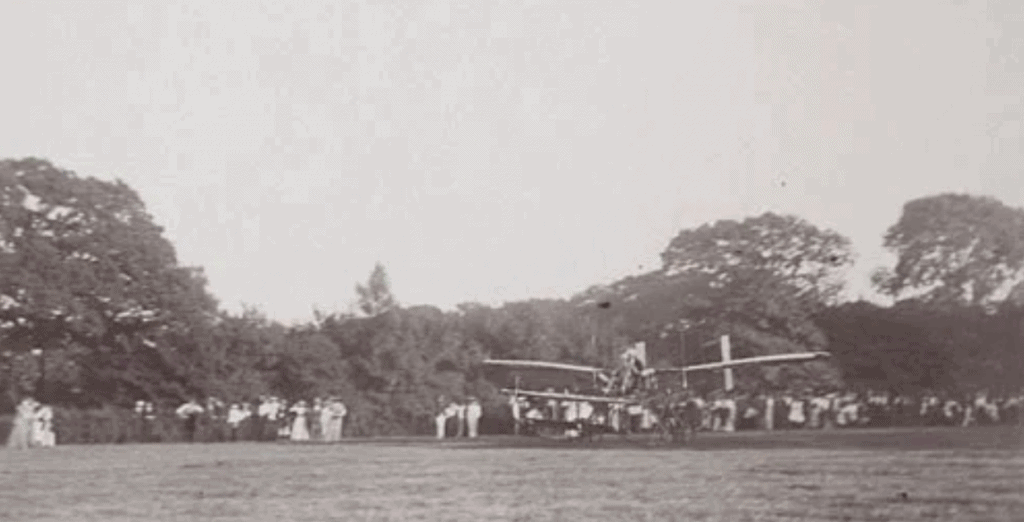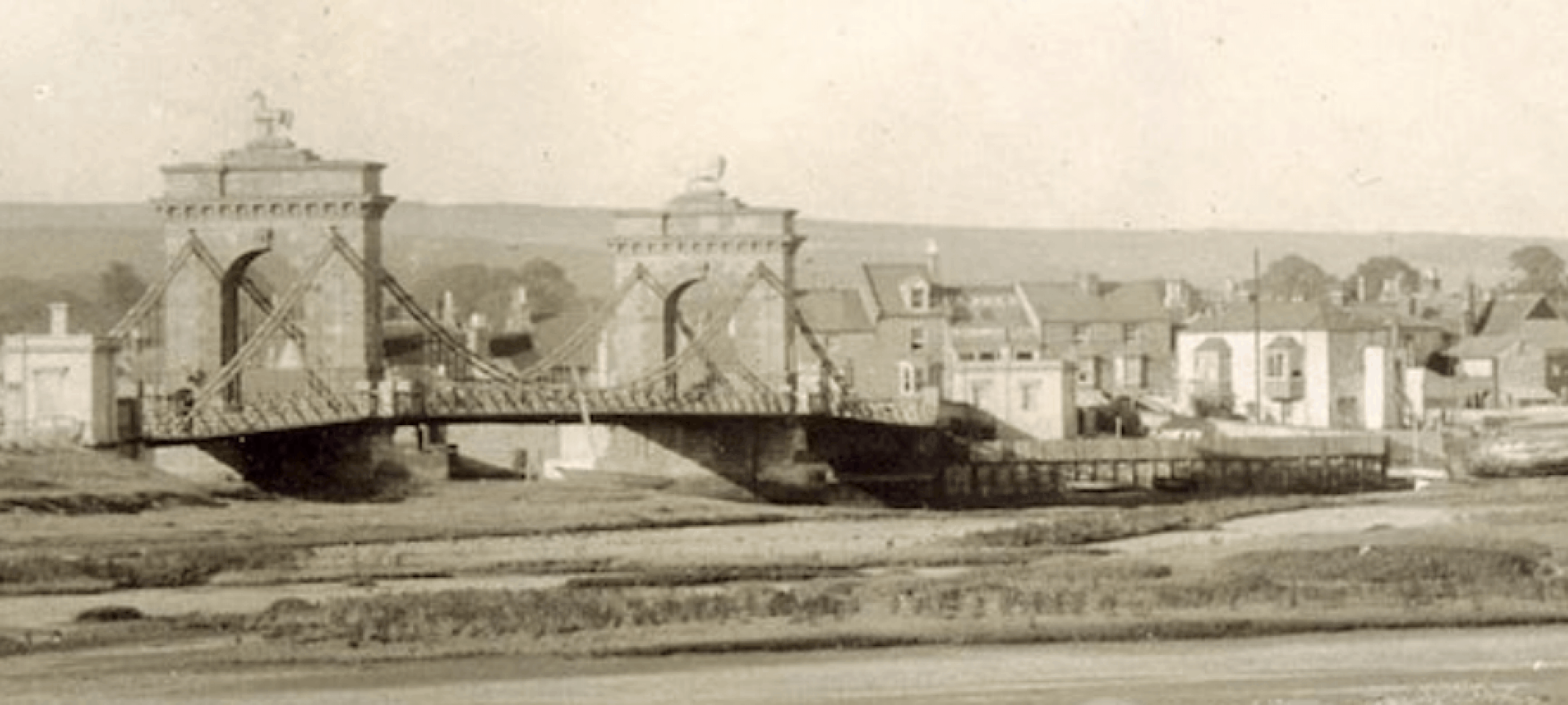Shoreham was becoming ever more popular with the flying fraternity, but the sisterhood were getting involved with this growing aviation lark, and on the 31st July, Horatio Barber took a young lady already gathering a reputation in the flying world, Miss Trehawke-Davies, on a flight from Hendon to Shoreham, in his own designed and built, ‘Valkyrie’ monoplane. The Belfast News-Letter, Saturday 5th August 1911 relays Barber’s story:-
‘The story of a remarkable flight with a lady passenger from London to Brighton (Shoreham) and back was told to the “Evening Standard” by Mr. Barber, the well-known aviator, who recently presented several aeroplanes to the War Office. At the offices of the Aeronautical Syndicate on the 30th ult, Miss Trehawke Davies, of 11 Portland Place, W., booked a return ticket for an aeroplane passage between Hendon and Brighton (Shoreham). Previously Miss Davies had made several less important cross-country flights on a Valkyrie monoplane. “We started on Monday”, said Mr. Barber, “at 5.55a.m. I took out a 50 h.p. Gnome Valkyrie racer, and ascended with Miss Davies in a slight breeze, making only two circuits of the aerodrome when we attained an altitude of 500 feet, and practically at six o’clock passed over the boundary of the flying ground in the direction of Brighton. Before reaching Harrow the wind had considerably increased from the south, and half an hour passed before we arrived over Brooklands track at an altitude of 1500 feet. Owing to the strong headwind I deemed it advisable to descend there in order to replenish the petrol tanks. In ten minutes this was accomplished, assisted by friendly aviators and mechanics. We at once resumed our journey.”
“An altitude of 1400 was maintained. Higher up the wind was found to be very strong, the barometer registering drops of 100 feet in a few seconds. When in sight of Lancing College and Shoreham Aerodrome the petrol supply was exhausted owing to the strong headwind, and we made a forced descent near Steyning in a four-acre field surrounded by trees. To ascend from such a restricted space is rather difficult, but we succeeded in flying through a gap in the trees with only three feet to spare, and in five minutes we landed at Brighton and Shoreham Aerodrome. The return journey was commenced at 7.56a.m. on the 1st inst., in spite of a twenty mile an hour wind. At an altitude of 1000 feet we flew in to the clouds and the wind increased to about 35 miles an hour. In ten minutes the Valkyrie was over Horsham. We descended on the golf links 1 ½ miles north of Horsham, and alighted at 8.7a.m., having travelled at a speed of about 95 miles per hour. Immense interest was shown by thousands of people from the surrounding country. Half a gale of wind blew all day, and it only calmed down towards 8p.m., when I decided to give a demonstration. A charge of 6d and 3d was made, and about 600 people availed themselves of this opportunity of examining the aeroplane and witnessing a flight at an altitude of 2000 feet. The proceeds were given to the local cottage hospital.”

Another sign of the growing belief in Shoreham Aerodrome as a commercial adventure, was a proposed flying race between Dieppe and Shoreham, about which, Flight magazine, 12th August 1911, reported details of discussions: –
‘The proposal to organise a flying race between Brighton and Dieppe has been well received in both places, and on Friday of last week two delegates from Dieppe visited Brighton in order to discuss the proposal. It was originally intended that the race should have taken place at the end of this week, but it has been decided to postpone it until September 2nd, and one suggestion is that there shall be one race from Brighton to Dieppe and another race from Dieppe to Brighton, substantial prizes being offered for each. Another idea, which seems to find most favour, is that the race should include the double crossing, starting from either side, with three prizes of £600, £200, and £100 respectively.’
As it happened, the Royal Aero Club vetoed the race, deciding the risks attached to be too great for the 80 mile crossing. Nonetheless, Shoreham had by now become a handy staging post for the emerging band of young aviators keen to ply their trade in and around Sussex and beyond. Not least of these was James Valentine, whose operations at Shoreham did not go unnoticed by:-
Flight magazine. Saturday 16th Sept. 1911
Brighton-Shoreham Aerodrome
The most important items of the past week were contributed by Valentine. On Wednesday afternoon he carried out some fine evolutions here before proceeding to Preston Park, where he put up a splendid exhibition before a large gathering at the Motor Gymkhana held by the car section of the Sussex Motor Yacht Club. On returning to the Shoreham Aerodrome he was warmly received by a considerable number of enthusiastic spectators.
On Thursday afternoon Valentine again had his Deperdussin out, this time taking his airing between the piers at Brighton, where the crowds on the front enjoyed a really splendid demonstration. At times he rose to a good height, and swooped down till the machine almost touched the water. Those who witnessed his return to the aerodrome will long remember the sight; flying low across the bridges, so that all might have a close view, he came to earth in splendid style at a speed of about 70 miles per hour.
Metzgar Bros. and Leno are working hard at their tests, which are proving very satisfactory. The new tractor biplane of Collyer and England has not been out yet, owing to a propeller bursting just after starting up for the initial flight.
September was a busy month for Valentine in the news, with many papers covering the aviator flying his Deperdussin to Dover on Thursday 21st September, here is the Worthing Gazette article:-
VALENTINE’S EXCELLENT FLIGHT.
From Shoreham to Dover in Seventy Minutes.
The aviator Valentine flew on Thursday from Shoreham to Dover, a distance of 80 miles, in exactly 70 minutes. He was assisted by a wind blowing at the rate of 20 miles an hour. He carried a letter from the Chief Constable of Brighton to the Chief Constable of Dover. His hands were numbed with cold, which rendered him unable to shut off the motor at the correct time. This caused the machine to dip, sticking her nose almost into the ground. He regained control, however, and landed safely.
Later in the day he gave an exhibition flight, and dropped a number of suppostitious bombs over Dover.
The aviation magazine, ‘Flight’, Saturday 25th November, reported on operations at Shoreham from the Week previous :-
On Wednesday of last week M. Chanter and Co.’s school machines arrived on the ground, and were safely housed in their hangars. Thursday saw the work of assembling being carried forward, and on Tuesday school operations were commenced. Lieut. J. C. Porte gave a splendid demonstration flight on Tuesday with his two-seater Deperdussin monoplane, coming to earth with a magnificent vol plane, after which he took Mr R. Preston, of Brighton, for a passenger trip.
Lieut. Porte’s passenger was actually Mr Richard Preston, brother of Harry Preston, who as proprietors of the Royal York and Royal Albion hotels in Brighton, involved themselves greatly in sponsoring flying events in the nascent years of aviation in Shoreham.
This would appear to have been the last aviation activity of any note to happen at Shoreham in 1911, the weather playing such a large part in those days of flying machines, constructed as they were by such lightweight materials that any decent gust of wind often put paid to many an aviator’s objectives. The air machines at this point in time were still some way off from being master over the elements.
Andy Ramus 2021
For the additional article chapters follow the links:

